With the uplands, the mountains, and the low, coastal plains, the ‘Bay State’ has a lot of environments for Avian species to make into a home and to thrive in. Today we will explore some of those species as well as the birding opportunities afforded in the great state of Massachusetts. We’ll talk about the seasons when you can see them, where they like to hide, and what they like to eat. Let’s talk about the popular backyard birds of Massachusetts!
3 Categories – 504 Birds
Many birds consider Massachusetts their home and at last count this is approximately 504 species! That’s a lot of fine feathered friends, as it were, and while we’d love to chronicle them all we’ve got to practice a little moderation. We’ve taken a few examples and we’ll divide them up seasonally in the following ctegories:
- Year-round Resident birds
- Birds of Spring, Summer, and Early Fall
- Fall and Winter Birds
This will give you a timeline of when to watch for the birds that you haven’t seen yet or simply wish to see again. You will also get an inside look at what they like to eat so that with a little planning and a lot of luck you might just earn yourself a new backyard resident. Let’s start with the ‘long timers’.
Massachusetts’ Year-round Resident birds
The birds which we have selected in this category have made Massachusetts their year-round home so you will want to keep an eye out. At any time of the year you can see them, be it warm or chilly, and many of them are quite the metropolitan birds… who will come to you! See if you can spot one of the following this year:
- Tufted Titmouse
- Mourning Dove
- Northern Cardinal
- American Goldfinch
- Downy Woodpecker
Tufted Titmouse – Baeolophus bicolor
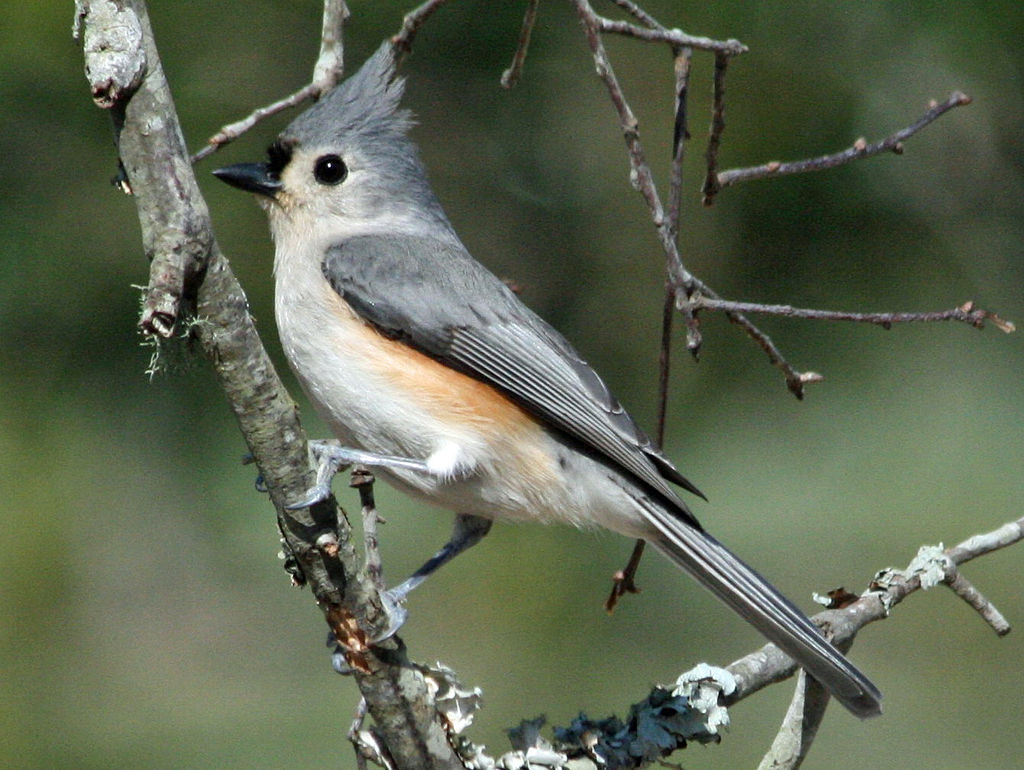
Coloration and Markings: The Tufted Titmouse has a blue-gray back, with small wings, and a long tail, both of the same color. The breast and underbelly of this bird are white, though there is a light orange-yellow wash present on the sides of the underbelly. Above, the white from the breast continues up to take up most of the face with the exceptions to this being on the upper portions. First, above the bill is a square black mark which joins to a small, soft blue-gray crest. Some blue extends from this crest just a little in front of the back of the head and this blue frames the eye on the sides.
Size: This bird measures in at 5.5 – 6.3 inches with wingspan of 7.0 to 10.2 inches.
Habitat: The Tufted Titmouse prefers lower elevation deciduous and Evergreen forests but they are also fond of parks and backyards so stock that feeder up!
Diet: These birds love suet. peanuts, and Black Oil Sunflower seeds. For a treat, try mixing up a little chunky peanut butter with some Black Oil Sunflower seeds and see what happens!
Mourning Dove – Zenaida macroura
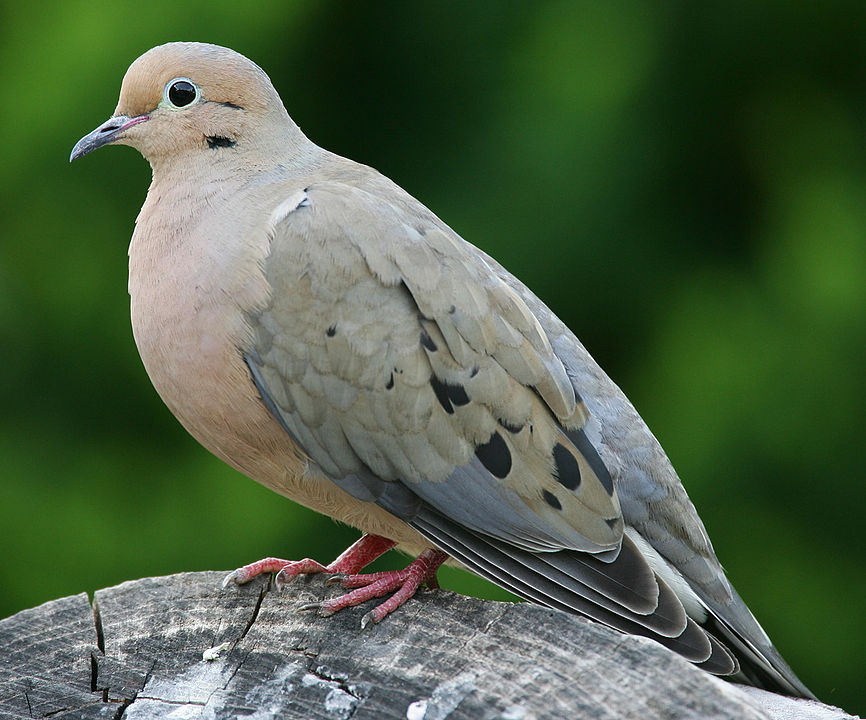
Coloration and Markings: The Mourning Dove has some simple, yet lovely coloration. There is a little variation based on region, but typically they will be brown or gray on the back, their large wings, and their long, thin tails. The wings have a heavy concentration of buffy or tan colo and distinctive black spots on present close to the center of each wing. The tail is also distinctive, with white tips and black on the borders. The breast and underbelly are much lighter in color, with a mix of whites and creamy tan coloration which lightens almost to white as the color approaches the underbelly. The head has the largest concentration of tan and you will also notice a white eyering on the bird’s face. This Dove has a medium-length, straight black bill.
Size: These Doves measure in at 9.1 – 13.4 inches from head to tail and have wingspans averaging 17.7 inches in length.
Habitat: These birds are city birds, so look for them taking walks on the sidewalk, hanging out on phone lines, or exploring backyards looking for tasty snacks.
Diet: You can tempt the Mourning Dove’s tummy with offerings of Black Oil Sunflower seeds, White Proso millet, and/or cracked corn.
Northern Cardinal – Cardinalis cardinalis
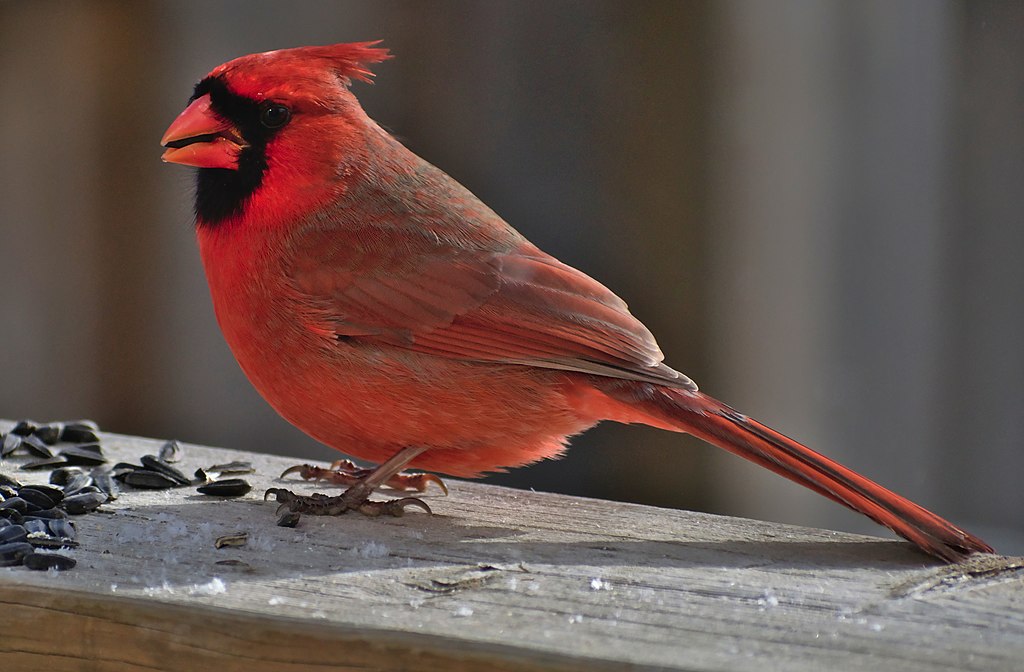
Coloration and Markings: Male Cardinals are the types of birds that inspire one to become a bird watcher. With the exception of molting-time for their feathers (when you might see a little gray), the males are completely red with some notable exceptions on the face. The first is their mask, which covers the eyes and continues front and center to give an ‘evil goatee’ just under the distinct, large and conical orange bill. This bird has a magnificent, large red crest and females will have a different coloration but also look quite nice. They are a soft brown, rather than fully red, though you can see tinges of red throughout their plumage. It is a beautiful look so whether your feeder gets a male or a female Cardinal it is still going to be quite memorable.
Size: These birds measure in at 8.3 – 9.1 inches in length with wingspans approaching 9.8 to 12.2 inches in width.
Habitat: While they might be found at the forest’s edge or foraging in a woodlot these birds are more commonly seen in the city. They are quite the urbanized birds and not shy about parks, phone lines, fences, or backyards. Leave a little something out for them and you might just make a a new friend.
Diet: Leave out some chopped apples, cracked corn, and peanuts… these are 3 favorites of the Northern Cardinal and they will be well-received.
American Goldfinch – Spinus tristis

Coloration and Markings: The American Goldfinch has a lot of cheerful coloration. The back of this bird is bright yellow, with long, black wings sporting 2 white wingbars on each wing and adding assorted vertical white marks on the lower portion of the wing and all over the pointy black tail. The breast and underbelly of this bird are also yellow but you will also see that the bird has a white rump, with some white extending towards the tail. Facially, we have more yellow, with the exceptions being a black cap that starts from the back of the head and terminates at the medium-length, conical orange bill. Females are less bright, with olive coloration showing above and a less vibrant yellow below and in the winter you’ll have to identify these birds by their wings and wingbars because their plumage will have turned a seasonal, dull brown.
Size: These cute little birds measure in at 4.3 – 5.1 inches in length and they have wingspans of 7.5 to 8.7 inches.
Habitat: These birds like to forage in weeds and dense vegetation and are especially fond of flood-prone areas where the hunting is good. They aren’t shy about visiting backyard feeders at any time during the year but in winter they might just visit in numbers. Be prepared.
Diet: Black Oil Sunflower seeds and Nyjer thistle mixed together can get excellent results with these birds. Give it a try and see if they notice.
Downy Woodpecker – Picoides pubescens
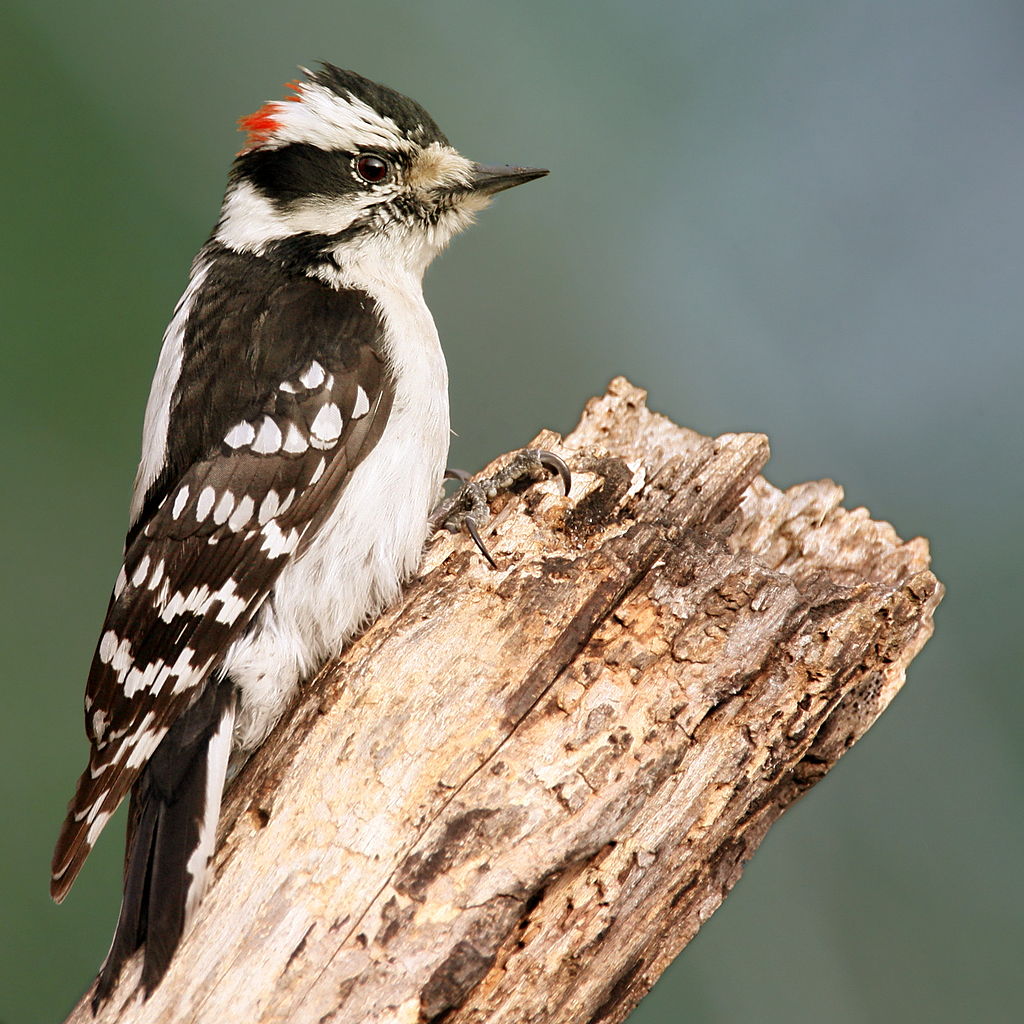
Coloration and Markings: The smallest North American Woodpecker, the Downy has a white back with long, black wings which has white, blocky lines and marks on them. This creates a checkerboard-stripe effect that is quite distinctive. The short tails look a bit like tuxedo tails in shape and they are black on top and white underneath. This bird has a snowy white rump, underbelly, and breast, and this white continues up to take up most of the face. You will also see some telltale facial markings, such as a black mustache line, a thin ‘bandit mask’ eyestripe going to the back of the head, and a thin, black cap on top that displays a red spot on the back of the head in male birds. This Woodpecker has a medium-length, straight black bill.
Size: Woodpeckers are normally quite big but not these guys. Downies measure in at a very cute 5.5 – 6.7 inches in length and have wingspans of 9.8 to 11.8 inches.
Habitat: These birds love decidous woods and favor oprn areas with a bit of brush or bramble cover. They are frequent visitors to backyard feeders throughout the year but especially in the winter.
Diet: You can feed these little guys shelled peanuts, suet, and Black Oil Sunflower seeds. All of these foods are favorites of the Downy Woodpecker and you might also see activity at your Hummingbird feeders. These birds have a sweet tooth.
Massachusetts’ Birds of Spring, Summer, and Early Fall
There are a few big hints when spring has arrived in the mighty state of Massachusetts. Wood Frogs start their melodies, accompanied by the songs of Chickadees, and the maple sugar brings it’s sweetness into play as everything gets greener and more colorful. From spring until the early fall a number of birds come to the Bay state to spend a little time and you can spot them if you know where to look. See if you can catch a glimpse of one or more of these birds:
- Cedar Waxwing
- Chimney Swift
- Baltimore Oriole
- Carolina Wren
- Red-winged Blackbird
Cedar Waxwing – Bombycilla cedrorum
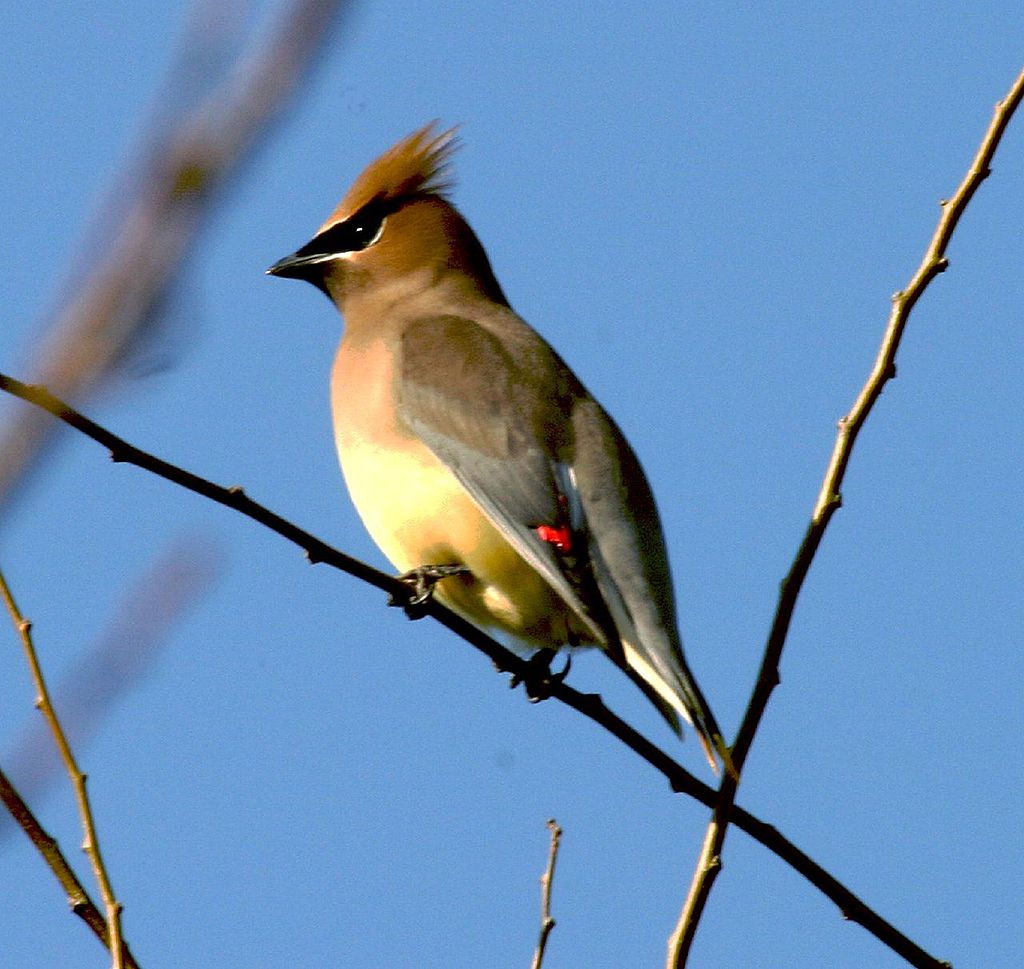
Coloration and Markings: Cedar Waxwings have some amazing coloration. The tops of their backs, as well as their shoulders, are a light but rich brown, with the rest of the back being a smooth gray. The lower halves of the wings are gray as well, with some black at the wingtips and a distinctive red-wax coloration moving across at the mid-wing level. They have short, yellow-tipped wings with a thick, black line above the yellow, and their breast is a light brown turning white and yellow as the color approaches the underbelly. Facially, this bird has a long ‘beard’ of light brown color falling down in to the breast and it also has a black mask band, under and ‘over’ lined in thin white, which curves up as it passes behind the eye and goes to the top of the head. Immediately in front of it’s termination you will see a tall, lovely crest which is short in width but quite noticeable. This bird has a short, stocky bill.
Size: Diminutive and lovely, these birds measure in at 5.7 to 6.7 inches in length with wingspans of 8.7 to 11.8 inches.
Habitat: These birds love the woods but are especially attracted to fruiting plants, spending a lot of time in home gardens, orchards, and at backyard feeders where they’ve found a treat or two that they like.
Diet: Fruits and berries are your best bet with this bird. Leave some chopped apples or cherries out and you might just get the attention of a Cedar Waxwing.
Chimney Swift – Chaetura pelagica

Coloration and Markings: The Chimney Swift doesn’t have a lot of fancy coloration. They are dark brown all over, with long wings and short tails, and noticeable lighter, almost-white coloration from the throat to the lower half of the face. They have rather wide bills but that is hard to notice while they are in flight, but you WILL notice their distinctive shape. These little birds look like quite like flying, unlit cigars!
Size: These birds measure in at 4.7 – 5.9 inches in length with wingspans of 10.6 to 11.8 inches.
Habitat: As the name implies, these birds sometimes nest in chimneys but in their absence any hollow will do, from trees, to rocks, to caves.
Diet: These birds eat insects but before you go stocking up that feeder with mealworms or dried crickets you should know that they prefer to catch their prey live. Sightings will be most likely of the bird foraging in flight. They catch mosquitoes and other insects this way and you can’t help but notice their distinctive shape. You can still try the dried insects but they will likely be more interested in your chimney.
Baltimore Oriole – Icterus galbula
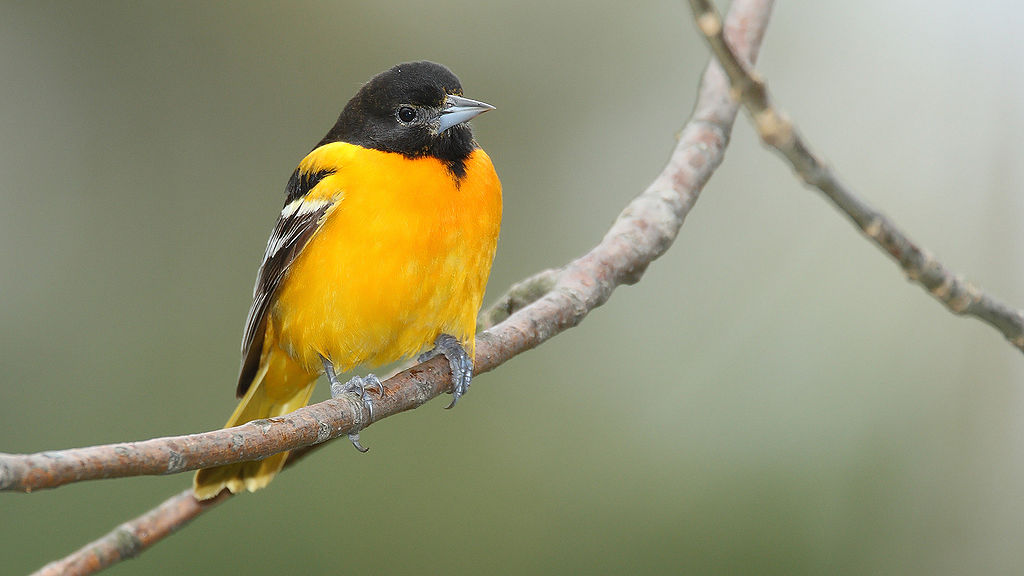
Coloration and Markings: Even Red Sox fans have to admit that these birds have some nice coloration. The Baltimore Oriole has a mostly black back, which turns a fierce orange as the color approaches the tail. You’ll see orange with some black marking at the shoulders, while the rest of the long wings are black with some heavy white markings accenting the plumage along with 2 noticeable wingbars. They have long, pointy tails which are black on top and orange at the edges and underneath, while the breast and underbelly of this bird are an undisturbed, vibrant orange. Their heads are almost completely black, with the exception of a thin, white eyering and a long, thick and pointy silver bill. Females and juveniles will have grays in place of blacks and be a lot more yellowish, rather than orange, but don’t worry, you can still see those distinctive wingbars and other identifying traits.
Size: These birds measure in at 6.7 – 7.5 inches with wingspans of 9.1 to 11.8 inches.
Habitat: These birds love open woods and may be seen in meadows, at the forest’s edge, or high up in trees next to rivers. They are not shy about visiting feeders but your chances of a visit are increased if you’ve got some tall trees.
Diet: These birds love fruit and a great way to attract them is to simply half some oranges and circle them with cherries. These birds love both fruits and may well come to dine at your feeder.
Carolina Wren – Thryothorus ludovicianus

Coloration and Markings: Caroline Wrens have reddish-brown backs and short wings of the same color, with the exception of some minute ‘checkerboard’ black and white at the edges and a very thin wingbar-type line. They have long, perky rust-brown tails with more checkerboard edging and their breast and underbelly are a light and pleasant yellow-orange color. This color extends up to the base of the throat and then changes to white which terminates vertically under the bill and horizontally at the edge of the cheek. Some black peppering is visible under the eye and there is a large, white eyebrow mark that gives this Wren an ‘Angry Birds’ look and it is right above a brown eyestripe. The top and back of the head are brown and this bird has a long, lightly curved black or brown bill.
Size: These birds measure in at 4.7 – 5.5 inches in length with wingspans of approximately 11.4 inches.
Habitat: These are birds of brushes, brambles, and thickets. They love to forage or simply sing from the safety of some shrub cover, so look for them there. If you have dense areas in the backyard then this will increase your chances of a visit.
Diet: These birds might not pay any attention to Black Oil Sunflower seeds, but they might very well take notice to suet and peanuts being left out for them. Give it a try and see for yourself!
Red-winged Blackbird – Agelaius phoeniceus

Coloration and Markings: The Red-Winged Blackbirds are easy to identify. When at rest, they are completely black with the exception of a yellowish vertical shoulder mark topped with red. This red often looks the shape of a shark fin and you can’t miss the mark. When the bird extends its wings and you can see the back, you can see a really amazing network of thin yellow and red, as if some stylish stitching was done between the wings. It’s rare to get to see it but it will make your day if you do! This bird had a long, stout and conical black bill.
Size: Roughly Robin-sized, these Blackbirds measure in at 6.7 – 9.1 inches from tip to tail and have wingspans of 12.2 to 15.8 inches.
Habitat: These birds love open areas, such as fields and meadows, but more often they are attracted to water. Look for them at wood-edge streams, next to ponds, or foraging in marshes.
Diet: White Proso millet and Black Oil Sunflower seeds sometimes work with this bird, but you will want to sprinkle them on the ground near a ground-style feeder to potentially get their attention.
Massachusetts’ Fall and Winter Birds
With lows around 16 degrees Fahrenheit, Massachusetts winters can be a bit chilly but are generally not too extreme. A number of birds don’t mind the temperature drop and continue about their day, foraging and looking for a new backyard where the snacks are reliable and the scenery is nice. See if you get a visit from one of these birds this winter:
- Dark-eyed Junco
- Black-capped Chickadee
- European Starling
- Hairy Woodpecker
- American Tree Sparrow
Dark-eyed Junco – Junco hyemalis

Coloration and Markings: Look for a brownish or gray bird that looks it has the lower 1/3rd of it’s body dipped in off-white paint. The Dark-eyed Junco has smooth dark brown or steely gray coloration on its back, long wings, and the top of it’s long, squared tail. You will notice white outer feathers on the tail and white on the undersides coming from the rump. The breast and underbelly of this bird are a ‘dirty white’ mix of white and gray, with heavy dark gray flanking at the breast which thins as it approaches the underbelly. It is thick enough that the white will only take up a central column at the breast. Facially, this bird is dark brown or steely gray throughout and it has a medum-length, conical pink bill that you can’t miss. There are lots of regional variations, however, so be sure to check our references if you think you’ve spotted a Junco but it looks slightly ‘off’ from a few description points.
Size: These birds measure in at 5.5 – 6.3 inches in length and have wingspans of 7.1 to 9.8 inches.
Habitat: When it’s warm these birds like coniferous or mixed-coniferous forests, spending more and more time at the forest’s edge, parks, and backyards as wintertime approaches.
Diet: Dark-eyed Juncos might visit the feeder for some cracked corn, White Proso millet, and hulled Black Oil Sunflower seeds.
Black-capped Chickadee – Poecile atricapillus
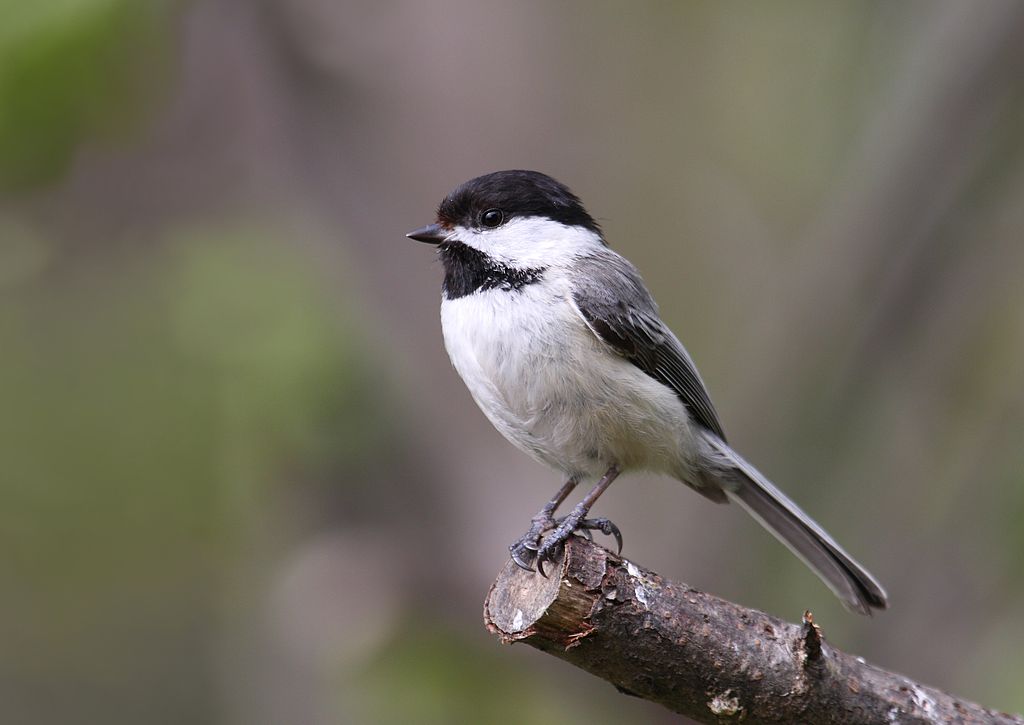
Coloration and Markings: Black-capped Chickadees have a simple, distinctive coloration scheme that makes them beautiful and easy to identify. These birds have soft gray backs, with long, gray wings sporting some white edging and long, gray tails with white outer feathers. This bird also has a snowy white breast and underbelly, with a faint tan wash flanking the sides, and most of the face is white with a few little exceptions. This birds has a black bib from the base of the throat until under the bill and a large, black cap across the head that stops vertically just under the eyes. They have tiny, conical black bills.
Size: These little birds measure in at 4.7 – 5.9 inches in length and have wingspans of 6.3 to 8.3 inches.
Habitat: In the forest or the suburbs this bird is comfortable, provided there is some dense vegetation in the form of shrubs, thickets, brambles, briars, or thorns.
Diet: Black-capped Chickadees have a weakness for suet and peanut butter. Add these to the feeder and see if the Chickadee notices!
European Starling – Sturnus vulgaris
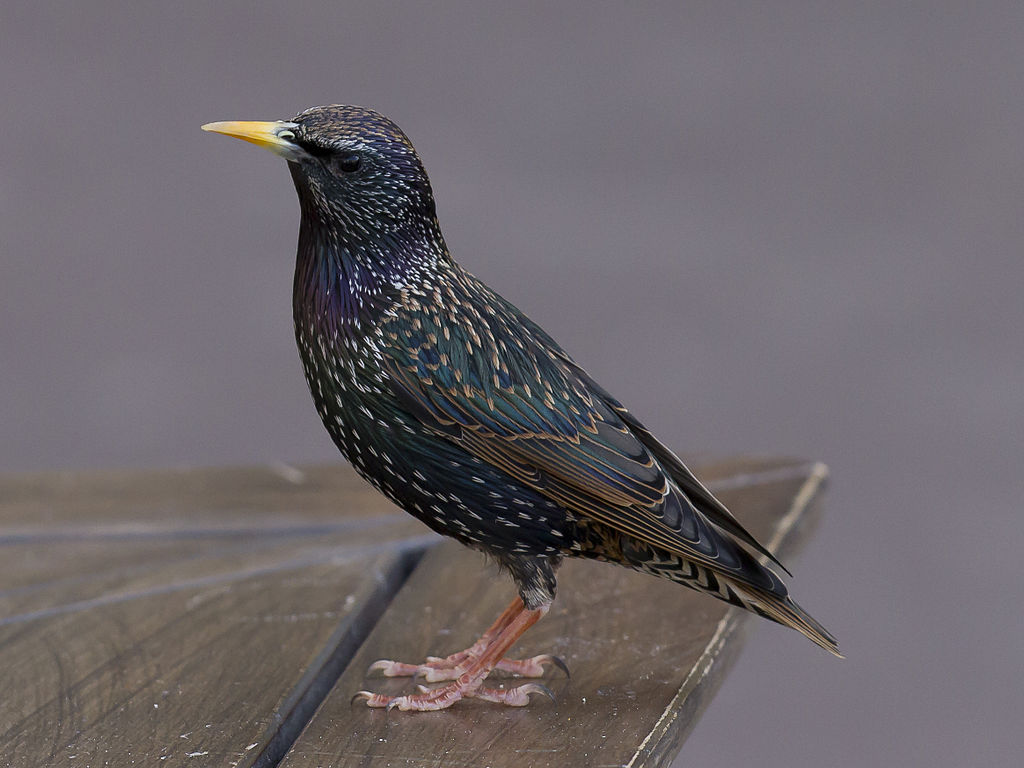
Coloration and Markings: European Starlings look black from afar but up close they are a shiny mix of purples and greens all over their bodies. They have long, straight yellow bills and in the winter they change their plumage dramatically, displaying brown with distinctive white spots.
Size: These birds measure 7.9 – 9.1 inches from tip to tail and have wingspans of 12.2 to 15.8 inches.
Habitat: European Starlings are city birds, so you’ll see them on fences, phones lines, walking on sidewalks, and scoping out your backyard. They aren’t shy about visiting feeders or sneaking into your shed if you’ve got any grains in there.
Diet: Dried crickets are a good idea, as Starlings love eating crickets and grasshoppers, but you can also have a little luck with White Proso millet, wheat, and oats.
Hairy Woodpecker – Dryobates villosus
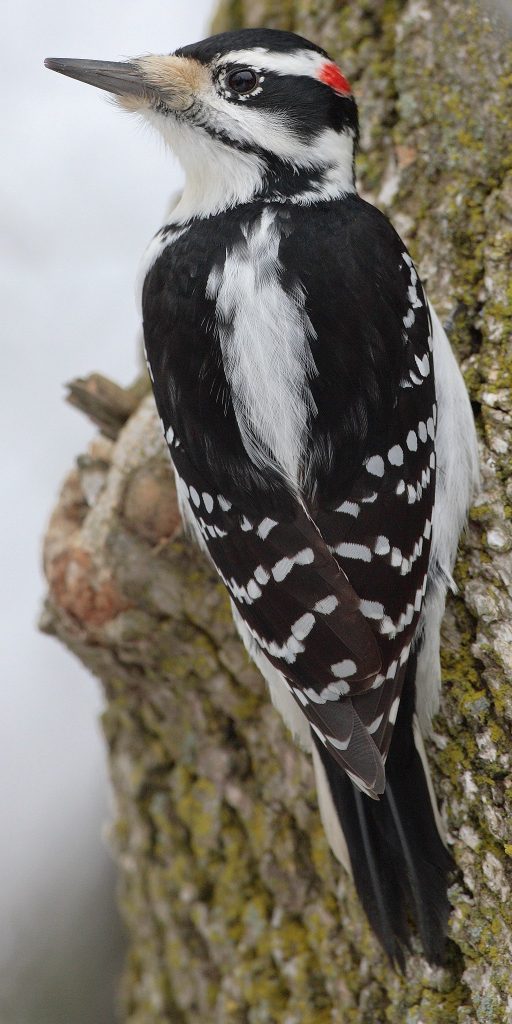
Coloration and Markings: We know what you are thinking and no, we aren’t trying to list the Downy Woodpecker twice. It just so happens that the Hairy Woodpecker and the Downy have identical coloration but a big difference in size as you will see below.
Size: Around 1/3 larger than the Downy, the Hairy Woodpecker measures 7.1 – 10.2 inches from head to tail and has a wingspan starting at 13 inches to as large as 16.1 inches. Think of the Downy, only Robin-sized.
Habitat: These birds like older forests, especially with some mature hard woods, but you can also find them in parks, suburbs, around old, rotting logs (for beetles and other yummy snacks), or in backyards that sport welcoming feeders.
Diet: These Woodpeckers love suet, Black Oil Sunflower seeds, and peanuts.
American Tree Sparrow – Spizella arborea

Coloration and Markings: American Tree Sparrows are tiny and handsome, with streaked brown and gray backs, Long wings with brown straking towards the center and gray on the outsides, as well as 2 distinct white wingbars, and long, gray tails with some white on the undersides. They have paper-white breast and underbelly, with some faint brown color flanking just under the wings and next to the shoulders, and facially these birds have gray faces, with a small brown mustaches mark, a brown eyeline which passes through the eyes and curves downward, stopping just shy of the back of the neck, and a rusty-red crown above. Sometimes there will be a rust mark on the center of the breast, but not always, and this bird has a short, straight bill that is often black on top and yellow below.
Size: These little birds average about 5.5 inches in length and have wingspans of approximately 9.4 inches in width.
Habitat: These birds may be found in marshes, at the forest’s edge, and virtually anywhere else where there is some dense vegetation in the form of shrubs, bushes, brush, or brambles.
Diet: White Proso millet, wheat, oats, and Black Oil Sunflower seeds are all excellent choices for tempting the American Tree Sparrow.
Supporting cast (Other Backyard Birds of Massachusetts that might pay you a visit)
We’ve got a bonus roster of year-round birds that you can add to your list and while they don’t get the fancy first-page billing, these little celebrities will certainly not disappoint you. See if you can spot some of our ‘Supporting Cast’ this year when you are out in town or sipping some coffee on the porch:
- White-breasted Nuthatch
- Blue Jay
- Gray Catbird
- Song Sparrow
- American Robin
White-breasted Nuthatch – Sitta carolinensis

Coloration and Markings: The White-breasted Nuthatch has a bluish-gray back, with short wings of blue-gray with black feathers interposed for accent, and with short, perky gray and blue tails with a little black on the sides and white underneath. They have a snowy white breast and underbelly and you might notice if the bird stays still that it has a reddish-brown mark on its rump. The white from the breast carries up into the face and a very light peppering of darker color accents the eyes and cheek (very light, so it will look completely white from a distance). This bird also has a thin, black line coming out from the back from the eye and arching up diagonally and it has a thin black cap starting from the bill and going all the way back to the shoulders and back. This bird has a straight, medium-length black and gray bill.
Size: This bird measures in at 5.1 – 5.5 inches in length with a wingspan of 7.9 to 10.6 inches.
Habitat: These birds love the deep woods but also spend a lot of time at the forest’s edge. They spend most of their time in deciduous woods but visits to coniferous woods are not uncommon.
Diet: These little guys are mostly insectivorous, though they might visit your feeder for a little suet.
Blue Jay – Cyanocitta cristata
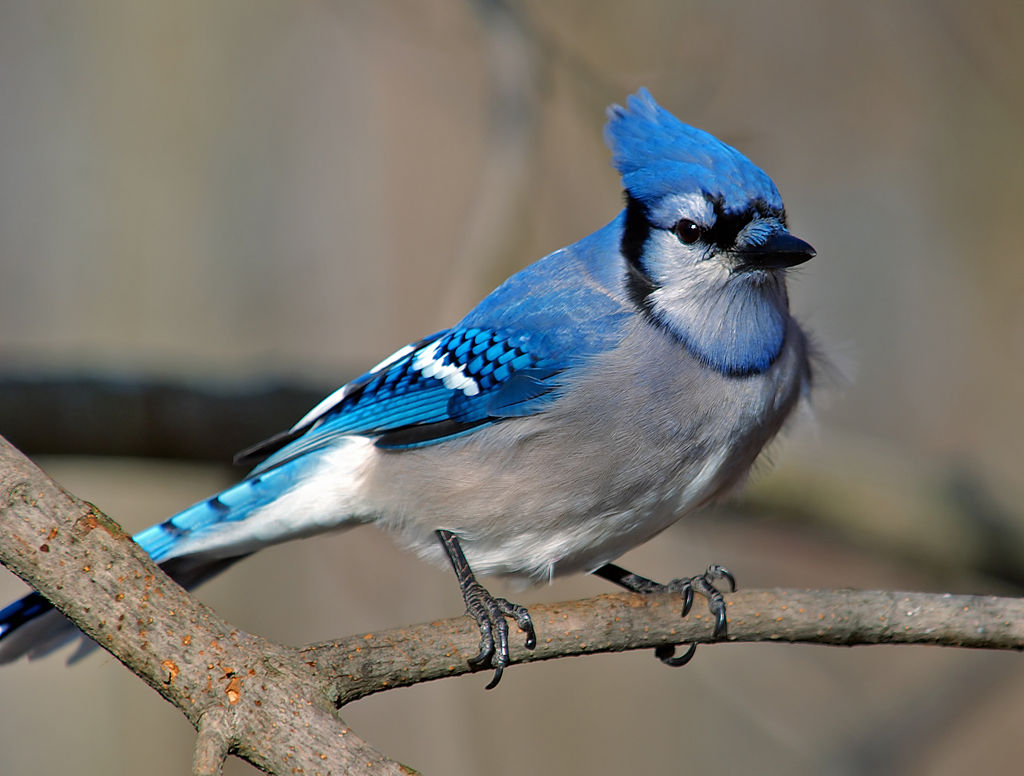
Coloration and Markings: Blue Jays are birds you will never tire of seeing. They have light to dark blue backs, with black outlining blue in scaling patterns on the wing just above a distinct, white wingbar. Further down the wing you will notice more blue scales and some larger white ones, also outlined in black, as well. These birds have long tails and here the scaling is quite symmetrical and consists of light blue outlined by darker blue, darkening to black towards the tip of the tail. The undersides of the feathers are paper-white, as is the rump, underbelly, and breast of the blue jay. This white continues up to take up most of the face with a few exceptions. There is a black line which comes from the back of the Jay’s magnificent light-blue crest and this black line encloses the face by circling around the base of the throat to the other side. This bird has a thin, ‘zigzagging’ black mask that looks lovely and a bit abstract and the Jay has a long, straight black bill.
Size: These birds measure in at 9.8 – 11.8 inches in length and have wingspans of 13.4 to 16.9 inches.
Habitat: These birds spend a lot of time at the forest’s edge and are especially fond of Oak trees, where they might acquire and snack on delicious acorns. They are not shy of the city, however, and range forth into parks, suburb fences, and backyards with feeders stocked in anticipation of their arrival.
Diet: Blue Jays love a number of different foods and you can’t go wrong by leaving out some suet, peanuts, Black Oil Sunflower seeds, or good ol’ cracked corn.
Gray Catbird – Dumetella carolinensis

Coloration and Markings: Gray Catbirds are almost completely stone gray, with long, gray wings and long tails which are gray on top and black below. The breast and underbelly are also the same gray but at immediately after the rump this bird has a red to reddish brown coloration which is a telltale identification sign. Facially, this bird has a thin, black cap and a long, straight black bill.
Size: Roughly Robin-sized, these birds measure in at 8.3 – 9.4 inches in length with wingspans of 8.7 to 11.8 inches in width.
Habitat: These are birds of dense vegetation, so look for them in weedy fields, bushes, shrubs, brambles, and thickets. They do like water as well so dense cover next to a stream or pond might just house a Gray Catbird.
Diet: Gray Catbirds love fruit, especially oranges and bananas. Put some out and you might very well attract some happy, hungry Catbirds.
Song Sparrow – Melospiza melodia
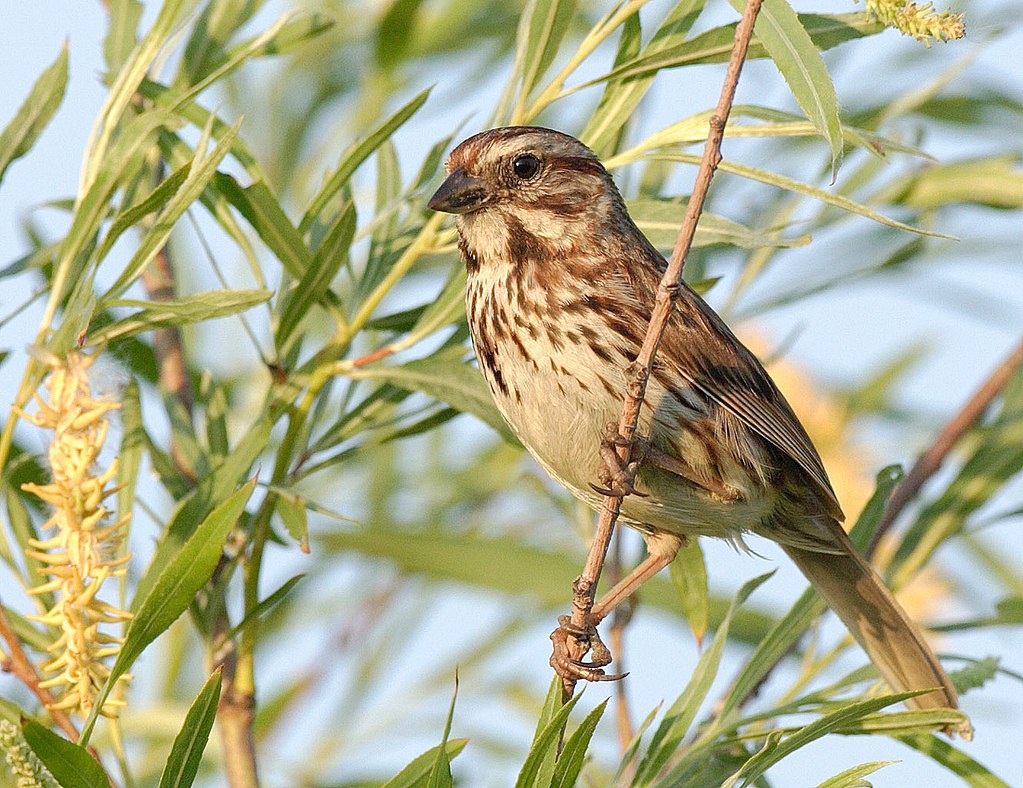
Coloration and Markings: Song Sparrows have gray backs with heavy brown streaks, with medium-length wings which are streaked at the shoulders, brown towards the center, and often grayish at the tips. They have long, perky brown tails and their breast and underbelly is an off-white with heavy brown streaking. They are white at the rump and you can see it if the animated little bird stays still for just a moment. Facially, this bird has a gray face with a white mustaches line flanked by brown stripes, a brown eyestripe that extends to the back of the head, and a brown stripe at the crown. This bird has a short, straight, and stout gray bill.
Size: These musical little guys and gals measure in at 4.7 to 6.7 inches from head to tail and have wingspans averaging 7.1 to 9.4 inches.
Habitat: These birds love the forest’s edge and other open areas, so look for them in meados, fields, parks, copses, and yes, in backyards. These birds aren’t shy about singing for their supper so leave out a little something that the Sparrow likes and you might just earn a visit!
Diet: These birds are easy to please, just put out some Nyjer thistle and some hulled Black Oil Sunflower seeds in your feeder and watch what happens when the little Sparrows spot it!
American Robin – Turdus migratorius
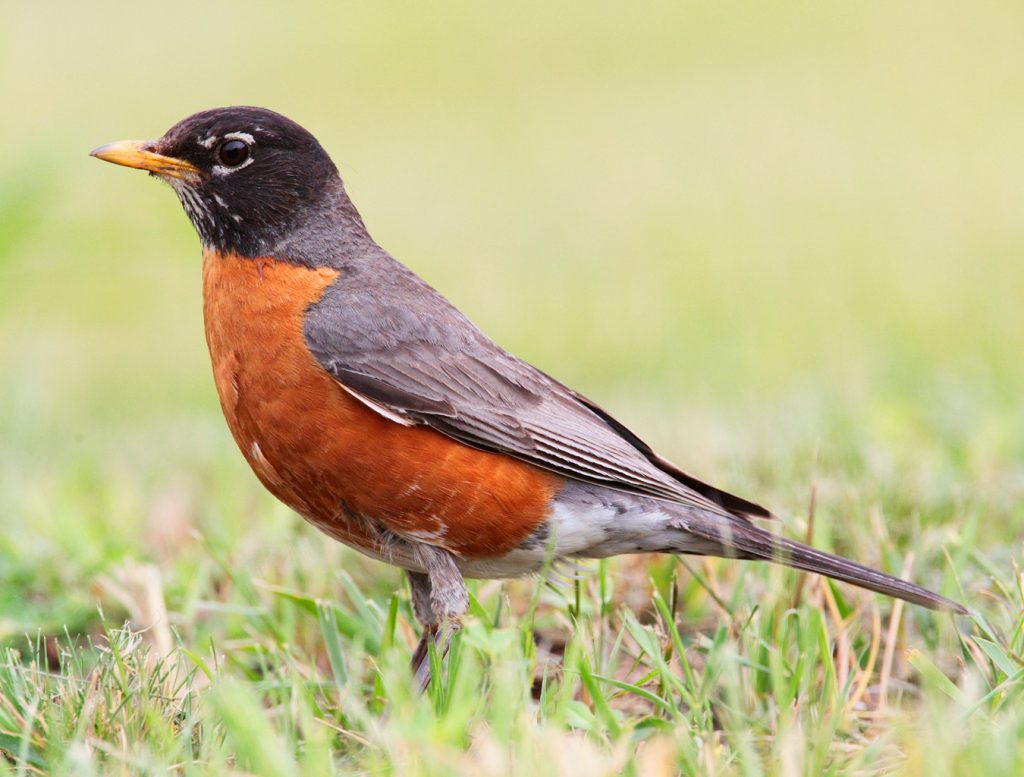
Coloration and Markings: American Robins are brown or dark gray on their back, long wings, and thei long tails, though you will see some minute white edging on the tail. They have an orange breast and underbelly with a noticeable white rump and facially, this bird’s face is much darker gray to black! You will notice a distinct, fragmented eyeline and this bird has a short, stout, and slightly curved yellow bill that often displays a tiny tuft of white underneath. Females have paler coloration and their colors are not as vibrant, contrasting less than you would see with the male.
Size: These birds measure in at 7.9 – 11 inches in length and have wingspans of 12.2 to 15.8 inches.
Habitat: Robins may be found just about anywhere. When they are in the woods they prefer the deciduous variety but it is not uncommon to see them in fields, farms, golf courses, or even hopping around in the snow. They will be more than happy to visit your feeder if you’ve left them a little something to sup on.
Diet: Chopped apples and mealworms will make American Robins very happy and it doesn’t take much effort to prepare, so give this combination a try when you have the time. It quite often gets the desired results.
Massachusetts Bird Buffet
If you are looking to find your own ‘secret recipe’ for the best Massachusetts bird feeder combination then you are in luck. We’ve got a little of our own advice and some from the Massachusetts Audubon in regards to sme of the best seeds to be sure to leave out. Check our references if you would like to read more from the Audubon as they also have a little general feeder advice which you might enjoy. Be sure to leave out one or more of the following in your feeder for best results with your local birds:
- Black Oil Sunflower seeds
- Nyjer thistle
- White Proso millet
- Grape jelly
- Crunchy peanut butter
Massachusetts Birding Hot Spots
If you are looking to get out of the house for a little birding run then you should take the Chirparazzi’s advice and visit one of the hotspots below. Massachusetts has a number of parks and trails that are often just around the corner and to make things easier we’ve selected a few at the compass points and center of the state. If you don’t see anything close, however, just check our reference link and between this and the Google-maps interface that the reference page employs you’ll be able to find something closer to home. See if you can make some time to do a little bird watching in one of the following prime locations:
- Northern hotspot – Nashua River Rail Trail
- Eastern hotspot – Norwell Pathway
- Southern hotspot – Blackstone River Greenway
- Western hotspot – Manhan Rail Trail
- Central hotspot – Upper Charles Trail
Detailed descriptions of each location as well as information regarding visiting and what birds you can see at these locations may be found at: https://www.traillink.com/stateactivity/ma-birding-trails/
In Conclusion
As you can see, the Bay State is indeed a fine, fine place to do some quality birding. Whether you are a local or an outsider looking to visit, we hope that the information which we have provided today will help to make a little difference when it comes to locating that elusive bird you are looking for. Until next time, keep those binoculars polished and don’t forget to bring those snacks… for you and of course, for the birds!
